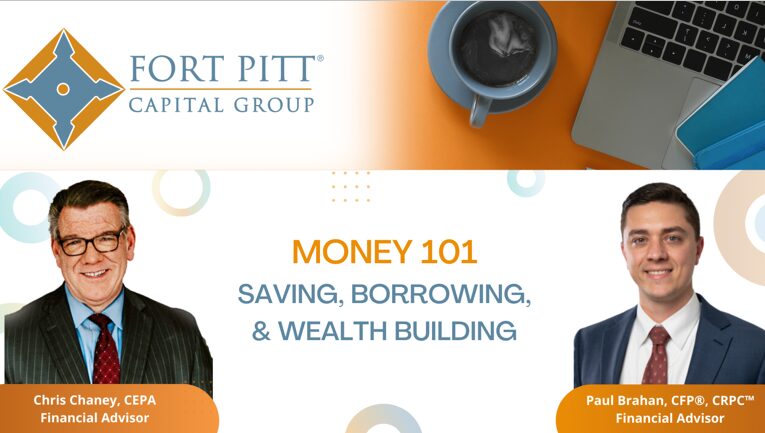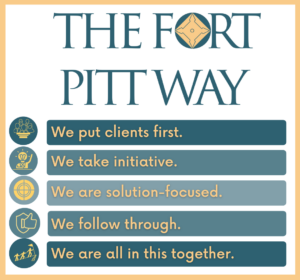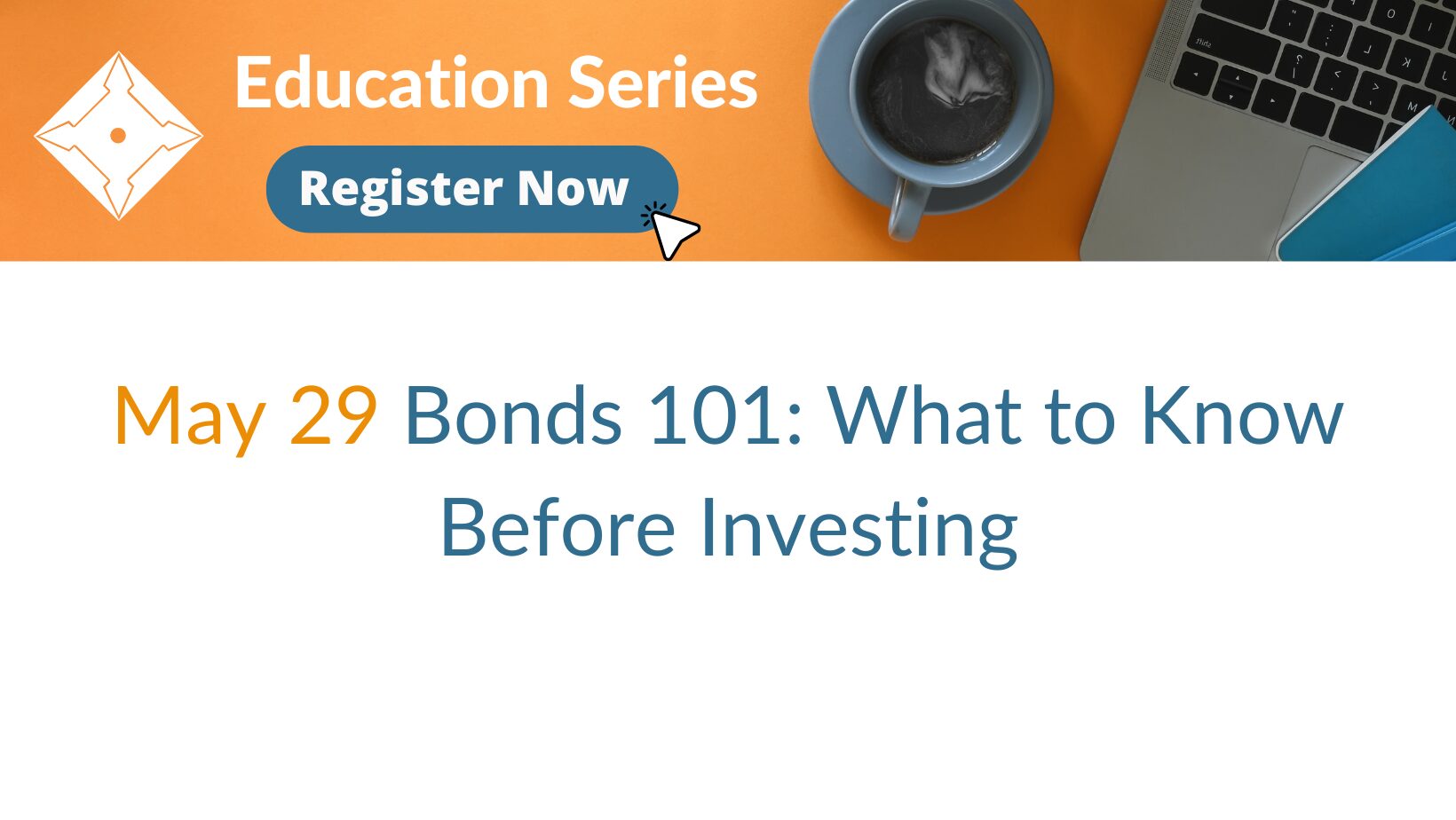Money 101 Saving, Borrowing, and Wealth Building

You work hard for your money. So, make your money work hard for you. Join Fort Pitt Financial Advisors Chris Chaney, CEPA, and Paul Brahan, CFP®, CRPC™ as they create a guide to money, offering a comprehensive overview of building wealth, covering the following key areas:
- Understanding assets from cash to stocks and bonds
- Smart spending
- Strategic borrowing, saving, & investing
- Navigating market volatility
- When to seek an advisor
Chris and Paul will highlight the importance of maximizing assets through strategic investing while minimizing debt and borrowing wisely.
Watch the webinar here:
The following are important notes and takeaways from the presentation. Do not hesitate to reach out to Fort Pitt Capital Group with your investment questions.
First, let’s build assets:
Three basic types of assets are generally accessible to anyone with surplus money:
- Stocks – ownership
- Bonds – essentially loans
- Cash and Cash Equivalents.
There are two additional types of assets. These tend to require a fair degree of expertise and may not be as easy to trade:
- Commodities: oil, gold, silver, wheat, etc.
- Real Estate
Let’s stick with the basics for now.
What is Cash or a Cash Equivalent? This refers to actual cash or a deposit that will have the same value tomorrow. This would include savings accounts, money market accounts, and money market funds.
- Define the character and purpose of Cash.
- Stable
- Accessible
- MAY provide interest . . . but the interest is secondary to the stability and liquidity.
- Cash provides resources to meet short-term or near-term needs.
- Target: Keep 3-6 months of living expenses in Cash.
Bonds are often called “income” assets because they are generally defined by their interest. Bonds are effectively “loans” to a corporation (Corporate Bond), government (Government Bond or Treasury Bond), or municipality (municipal bond).
- They work like CDs. You don’t really “buy” a CD. The Bank wants to borrow your money and tells you what they are willing to pay you for it in terms of interest, how long they want to keep it, and when they will return it to you (when it “matures”).
- The key feature of bonds is the interest they pay.
- Generally, they pay more than cash equivalents. (Curiously, not right now.)
- The “Par Value” states how much you get back when the bond or note matures.
- You can buy them and sell them. Whether you can buy or sell them for more or less than the par value. Why? It depends on how attractive the rate you have is compared to current rates.
There are three key aspects to consider when investing in a bond:
(1) Credit Quality – this is the ability of the borrower to repay you when the bond matures.
(2) Term – this is how long it will be until you are paid back – that is, how long the money will be tied up.
They can be:
- Very short-term, called paper
- Short-term “notes” that mature in 1-10 years
- Or long-term “bonds” – from 10 to 30 years.
(3) Interest rate: what the bond pays.
It may pay you interest regularly, OR you may buy it at a discount, and it accrues in value until it reaches maturity—the promised value.
SO: when do you use bonds?
Bonds are great when you need consistent cash flow and when you need ongoing income from your portfolio for the next 4 to 6 years.
They can also potentially reduce the overall volatility of your investment portfolio.
How?
Bonds – high-quality bonds – don’t tend to be as volatile (rise and fall) as much as stocks. They CAN, but they don’t tend to.
Generally – though not always – they hold up better than stocks during periods of stock market volatility.
Remember: their return is primarily driven by the interest they pay . . . and the price you paid to buy it.
Be CAREFUL, though. We have often seen retirement plan accounts for people in their 20s, 30s, and 40s who have an allocation to bonds . . . in an account that they will not touch until they are at least 59.5 – and often not until they are 65 or 75. If you have 20 to 30 years to go before you access your retirement account, you need to really think about how bonds add value to your portfolio.
Stocks are considered “growth” assets because you are buying future profits. Over time, these tend to appreciate – to grow in value. That growth, however, does NOT occur in a straight line. Roughly 8 years out of 10 stocks have tended to grow.
Given the volatility of stocks – their ability to drop sharply – it is important to invest that portion of money you won’t need for at least five years in stocks.
- This is why they are considered “long-term investments”
- Recall 2008-9: the market dropped over 58% from peak to trough.
- If you had good stocks and could leave them alone, you would recover their full value in about four years.
Rule 1 for investing: Buy Low and sell high.
Emotional investing: Buy high (when comfortable) and sell low (when anxious).
This is disastrous . . . and why we have a job.
Rule 2: diversify.
There are three key reasons to diversify:
- Reduce risk. “Don’t keep all of your eggs in one basket.”
- Participate in growth where it occurs.
- The top reason is selective harvesting of what is “ripe.” (Sell high.)
Types of accounts:
- Personal accounts
- Retirement accounts (IRA, 401k, 403b, etc.)
- Roth IRA
These accounts are taxable (subject to annual taxation). You have restricted access to these assets when you need them. They are subject to taxation, so be aware of that.
- Trading can generate capital gains.
- Capital gains taxes are usually favorable – better – than other tax rates.
- Remember: paying taxes on a gain is better than trying to avoid taxes and watching the asset value decline.
- Because you have ready access to this account, it often warrants the most conservative strategy—if you need one.
Retirement Accounts (IRAs, 401k, 403b, etc.)
- These are tax-deferred and, as such, grow without incurring taxation on gains or income.
- These accounts are not as easily accessible.
- Withdrawals are taxed at income tax rates. (Higher than capital gains tax rates)
- Withdrawals before 59.5 are subject to a 10% penalty in addition to the taxes owed.
- At a scheduled age (73-75, depending on when you were born), you will be required to withdraw a specific amount each year. à RMD
Compare a $20,000 withdrawal from an individual account with a $20,000 withdrawal from an IRA.
Given the tax rate – our clients often limit the amount they take from their retirement accounts to what is needed. As a result, the vast majority of the assets in their IRAs are likely to remain invested for a long time. Given this time horizon, the IRA is likely to have a larger portion in stocks than the individual account.
When do I need to begin taking Required Minimum Distributions (RMDs)?
| RMD Age | Birth Year |
| 72 (or 70 ½) | 1950 or earlier |
| 73 | 1951-1959 |
| 75 | 1960 or later |
Exception: Active participants in employer-sponsored retirement plans who are still working.
Roth IRAs are tax-exempt accounts. Assets can grow tax-exempt and may be withdrawn – under certain circumstances – tax free as well. This makes the Roth IRA the perfect investment account.
Given how ideal it is for investing, it is likely to be the LAST account you want to access when you need money. When this is the case, your Roth IRA warrants the most aggressive growth strategy in order to maximize the long-term return potential of the account.
How to build assets:
1. Spend less than you make.
2. Pay yourself first and live on the rest.
3. Maximize your retirement plan contributions.
4. Remember that markets are volatile.
5. Dollar-cost averaging can build a large portfolio with constant, little contributions.
6. Buy low; sell high.
7. Diversify your investments so you can selectively harvest when you need money.
8. Tailor your strategy to the character and purpose of each account in order to maximize your money.
Now you may also need to borrow.
Most people will need to borrow at some time.
Whether it’s college, a car, or a home, borrowing allows you to buy or do more than you have in assets, but at the cost of an obligation to repay that money.
Key considerations when you are considering borrowing:
- What is it for? Will it enhance your ability to build wealth? College can. A house may. A car can – if it’s essential to your job.
- How much does it cost?
First, what portion of your income will be needed to repay it? It is critical to keep the portion of your income spent on repaying debt to a minimum!
Warning: this can get out of control very quickly. Approach ANY debt with caution.
Second: what is the rate? Expensive debt should be avoided.
We can help you with this decision and help clients find the best options when they DO need to borrow.
- A key rule when you have a need: ALWAYS USE YOUR “CHEAP” MONEY.
Money in a savings account that earns half a percent in interest is MUCH LESS expensive than a credit card that charges 24% or more. You use the “cheap” money: in this case, using savings only “costs” you half a percent. MUCH less than a credit card.
- Borrowing represents a degree of risk: you are counting on being able to repay it in the future. Prudent borrowing makes sense; it uses resources that “cost” less than your assets generate. This is prudent leverage.
- Excessive or careless borrowing can be – and often is – catastrophic.
- If you are a client who needs or is thinking about borrowing, please talk with your advisor. We can help you explore and identify the best solution for you.
We help our clients realize their financial goals and enjoy peace of mind.
Our goal is to help you maximize your assets, beginning with investment strategies designed to help you realize your dreams.
Our in-house portfolio management team will manage your accounts with carefully selected investments, rigorous attention to price (the risk is ALWAYS in the price), harvesting what is ripe, and “fertilizing” what is out of season to give you the best results over time.
Let us help you achieve YOUR financial goals.



